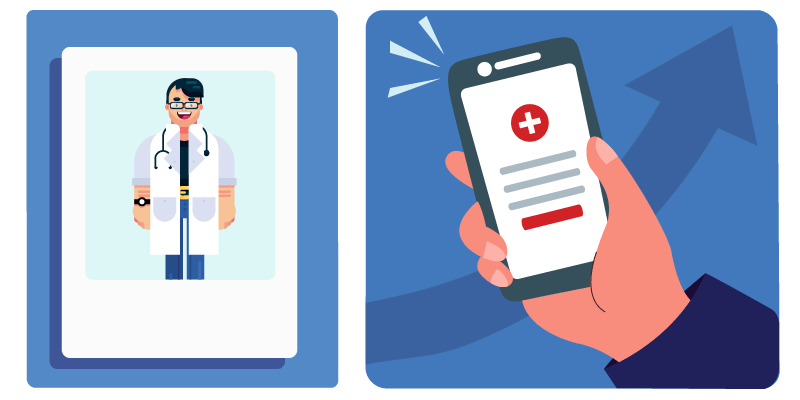Three marketing strategies to boost healthcare conversions

“I love filling out forms!” – said nobody, ever, especially when they’re trying to book a medical appointment online. When looking to schedule a dental procedure, dermatology consultation, or anything in between, the minute you realize the form never ends, or it becomes too confusing, you’re likely bouncing.
The healthcare landscape has changed dramatically. Gone are the days of settling for the closest practice to your home. Today’s patients have more power than ever, taking time to research their options before filling out a consultation form or making a call.
We know healthcare marketing can be challenging. You’re dealing with a sensitive topic – people’s wellbeing – and face steep competition. This means your website and landing pages need to be more than online brochures; they are important conversion tools. And although this sounds like another hurdle, as your marketing partner, we consider this an opportunity to leverage your digital footprint.
So, what tips can you use in marketing to improve healthcare conversions? Read on for some tried and true strategies that will help you turn more visitors into patients.
Conversion strategy: Optimize website content and keywords
Result: Align content with user intent to improve conversion rates by 47%.
Keyword research helps identify the terms and phrases your target audience will likely use when searching for your medical services.

Avoid over-optimizing keywords and instead optimize for user intent. User intent (or search intent) is the primary goal behind a user’s search query. Search engines prioritize user intent rather than keyword usage to rank content. In healthcare, you’re likely looking at people seeking knowledge or answers about something.
You can fulfill user intent by more than just long paragraphs of copy. Try incorporating guides or checklists, FAQs, videos, and educational materials with your content.
Conversion strategy: Simplify forms
Healthcare is not exactly known for concise forms. And we know why – the more information you can get from a patient, the more you know about them, and the better you can serve them.
However, your website isn’t the waiting room in your office. On average, about 68% of users abandon online forms. They might be too long, poorly designed, confusing, too far down the page, or asking for information people aren’t willing to share. The list goes on. While a 100% form completion rate is a pipe dream, the solution is clear: you have to make the process as simple as possible.
When your forms are short and straightforward, more users are likely to complete them. Only ask for absolutely necessary information initially. Research shows reducing the number of form fields boosts conversion rates. You can always gather more during follow-up communications, after a connection has been established.
To truly boost your conversion numbers, you have to think about what your patients are really trying to do. Consider designing forms that cater to different patient personas and their varying levels of intent.
- Quick Contacts for High-Intent Users: Some patients know exactly what they want and have already decided to book with you. These are high-intent users. Provide a direct booking option or a streamlined form that gets them scheduled with minimal friction. Think “Book Now” or “Schedule Now” CTAs with just the essential fields.
- Longer Forms for Lower-Intent Users: For those who may still be in the research phase or are unsure about committing to an immediate appointment, overwhelming them with a full booking form can be a turn-off. Instead, offer “Request More Information” or “Schedule a Free Consultation” CTAs. These forms can gather a little more detail, helping build trust without asking for their life story.
- Forms for Follow-Up: Once a patient submits an initial inquiry, that’s your cue for more detailed follow-ups. These forms can gather additional necessary information before their actual appointment. This strategy allows for a more prepared visit, all the while ensuring you don’t turn them off with excessive questions at their initial point of contact.
By simplifying forms and tailoring them to reflect the patient’s journey, you’ll create a more relevant experience, leading to higher healthcare conversion rates.
Conversion strategy: Enhance UX on mobile devices

Result: Increased number of conversions from mobile users
Don’t skimp out when it comes to mobile first design. Mobile brings 7x more traffic, but desktop converts 22% better – which means you could lose a significant number of conversions simply if your site isn’t mobile-friendly.
Here are easy tips to keep in mind when designing for mobile:
- Design with less space in mind: Mobile screens are a fraction of the size of a desktop monitor, so you have to prioritize what’s most important. Adapt your designs and focus on the main copy, the primary call-to-action (CTA) button, and a key visual.
- Keep forms simple: To design mobile-friendly forms (yes, we’re still talking about forms), use a single-column layout with minimal fields. Check that the text (font size and style) is legible. Nobody wants to pinch their screen and zoom in manually to read the text. And lastly, ensure the CTA button is easy to click.
- Speed matters: Everyone’s picky about page speed, but over half of mobile users will leave if a page takes longer than three seconds to load. Don’t bog down mobile sites with slow-loading videos, big pictures, or anything else that is taking up unnecessary bandwidth. If your page is still chugging along sluggishly, the backend of your site might need some cleaning up.
By creating web content that answers user questions, simplifying your forms, and ensuring a seamless mobile experience, your practice can significantly convert more visitors into valuable appointments.
Of course, there are more than three strategies you can use to improve your healthcare conversion rates. If you’re interested in learning even more, read our article here – 5 Ways to Improve Conversion Rates.


